Planning your Facebook ad budget can seem a little daunting when you’re just starting with advertising. How much money should you allocate to your first ad? How to know if your Facebook ads cost went over the roof? And how to reduce your ad spend?
Take a deep breath and relax.
In this article, we’ll explain everything you need to know about:
- How Facebook ad bidding works
- What factors influence Facebook advertising costs
- How to distribute your ad budget
- What’s the minimum ad budget for Facebook ads
- How to reduce your Facebook ad costs and a few more tips to help you with ads.
You’ll also find recent statistics on how much it costs to advertise on Facebook – use them as a benchmark for monitoring your ad spend.
Let’s make money, shall we?
How does bidding work on Facebook?
Advertising on Facebook is like participating in an auction. You come all dressed up and ready to get your ideal customer, and so do many other brands in your niche.
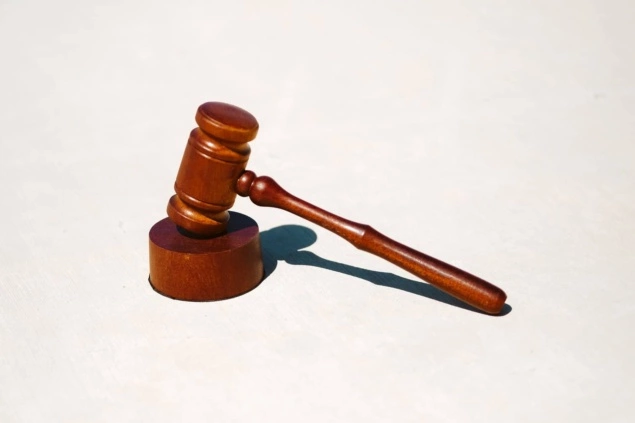
If Facebook gave you and your competitors the same advertising opportunities, Facebook users would feel overwhelmed with all the ads in their personal space. As a result, they’d start using Facebook less, and that wouldn’t be good.
That’s why Facebook controls the number of ads that its users get to see across the Facebook family of apps. The platform offers a limited number of ad placements and makes advertisers compete for ad space.
If you bid the highest, you’ll get the best spot for your ad. To stay competitive, make sure to work on a good bidding strategy.
Facebook offers three bidding strategies:
- Spend-based: The focus is on spending your whole budget and getting the most results or value possible.
- Goal-based: You set a cost or value you want to achieve.
- Manual: You control how much you want to bid across ad auctions.
Read more on bidding strategies here.
How much did it cost to advertise on Facebook in 2021?
A recent study by Wordstream has found that the average cost per click (CPC) in Facebook ads across all industries is $1.72.
However, Facebook advertising costs can vary by a lot depending on the industry, your ad placement, target audience, and multiple other factors.
Typically you can expect your ads to cost you between $0.50 and $2.00 per click.
If you’re in finance & insurance, your Facebook advertising costs may rise to as much as $3.77 per click. On the other hand, merchants in the apparel niche are only paying around $0.45 per click.
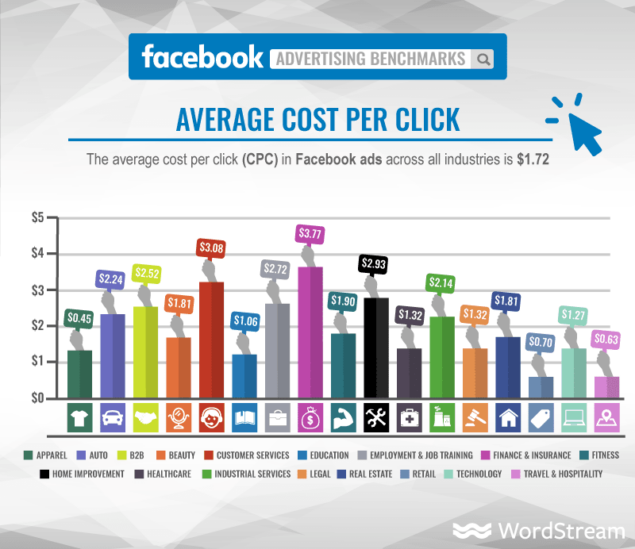
To give you a better understanding of how big your ad budget should be, in this article, we’ll cover the key findings by AdEspresso on Facebook ad cost averages for 2019 and 2020. We’ll also give tips to help you balance your Facebook ad spend for the best results.
But keep in mind that these statistics don’t necessarily predict how much it will cost you to run Facebook ads. Plus, you may find that different sources report different numbers. Look at them as a benchmark for you to set your own ad goals, but always monitor your own analytics to see what ad strategies work for you the best.
First, let’s have a quick look at the main factors determining the cost of advertising on Facebook.
7 factors that affect Facebook advertising costs
Before we get into more granular Facebook advertising statistics, let’s look at the main factors that affect Facebook ad costs.
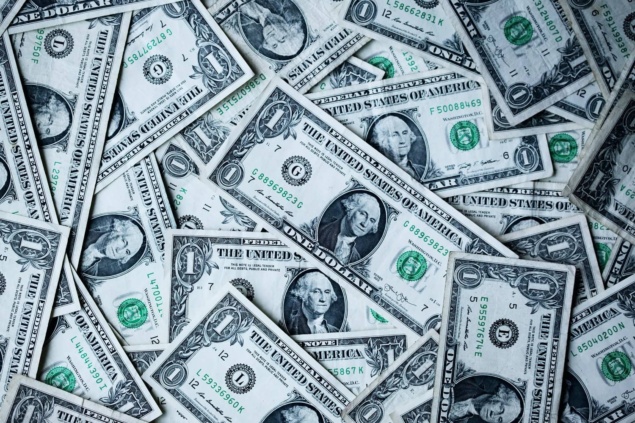
1. Industry
Your business niche significantly influences your ad costs. For example, Facebook ads related to insurance or finance will be more expensive than those promoting clothes.
2. Bidding strategy
Your bidding strategy is one of the key elements that determine your ad costs. You need to decide if you should go for the automatic bidding and opt-in for the lowest cost or control your ad costs manually instead.
3. Timing
The same Facebook ad may cost more or less during different hours of the day. Also, your ads will cost you much more during seasonal events when everyone is fighting over shoppers’ attention.
4. Audience
Your Facebook ad costs will rise, too, if you’re trying to reach the same demographics as many other advertisers at the same time.
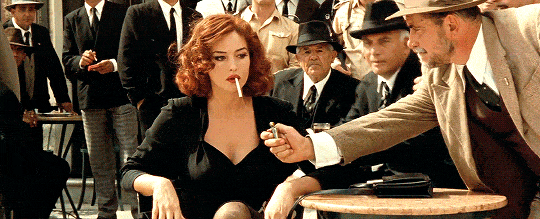
Keep in mind that you won’t be competing just with the brands in your niche. You’ll also compete with businesses that sell different products but target the same people like you, e.g., healthy eaters.
5. Ad placement
The more competitive your ad placement is, the more your ads will cost you.
6. Ad objective
If you choose the wrong objective for your ad, for example, using a lead generation objective when all you want is to increase your brand awareness, your ads will cost you more.
7. Relevance score
If your ads are not relevant to your target audience, their costs will be higher. Make sure you create quality ads that bring value to your potential customers and live up to their expectations, and you’ll spend less on advertising.
Facebook Ads cost: Statistics from real campaigns in 2019 and 2020
Now that you know what affects Facebook advertising costs overall let’s take a look at the key statistics by AdEspresso for 2019 and Q1-3 of 2020 to see how much you can expect to pay for your Facebook ads in 2022.
Facebook cost per click (CPC) per Month – 2019
In 2019, the average CPC increased from $0.31 in 2018 to $0.45 in 2019. This happened because, as we discussed at the beginning of the article, Facebook works like an auction. More advertisers were competing for ad space which led to higher CPC rates.
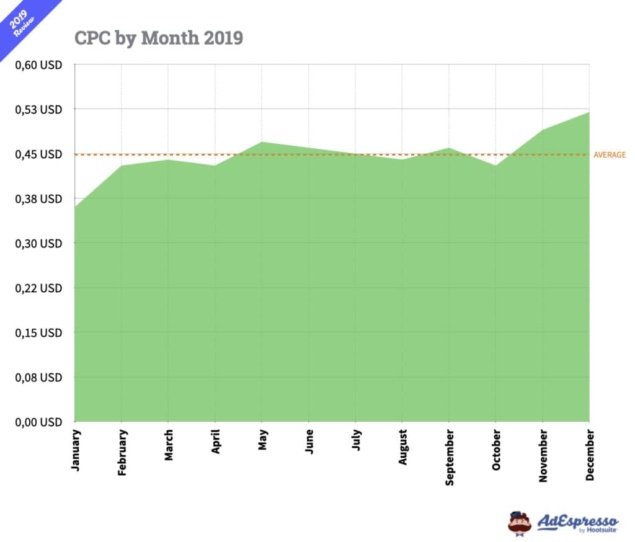
Facebook cost per click (CPC) per Month – 2020
You’d think that the ad costs would keep on rising in 2020, however, according to AdEspresso, it wasn’t the case. The average CPC dropped to $0.39 in March. The reason behind this change? Covid-19.
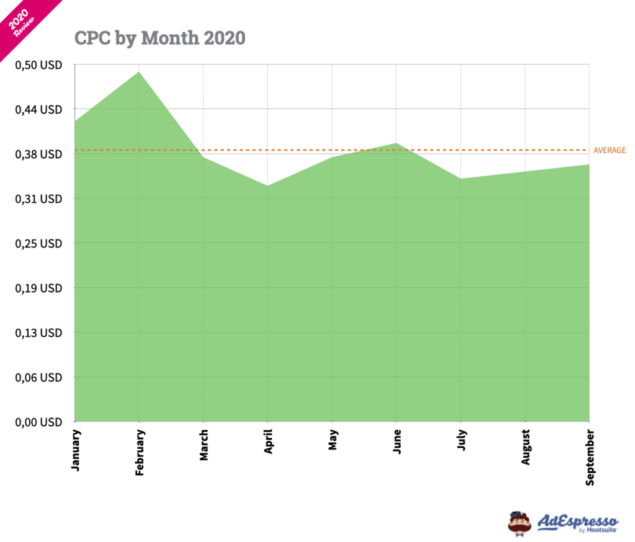
The beginning of the pandemic caused fear among many, and business owners cut down on their ad spend. However, those who were still running ads had a chance to get in front of their customers cheaper.
Facebook cost per click (CPC) by the hour of the day – 2020
You can reduce your Facebook ad costs by running your ads during specific hours of the day. In 2020, it got increasingly cheaper to advertise during the evening hours. The reason behind this is the pandemic again.
In 2020, it was the most expensive to advertise during daytime hours between 9 AM to 5 PM. Many of us were working from home and spent more time on social media checking the latest news during the daytime, and advertisers were eager to get in front of us when we were online.
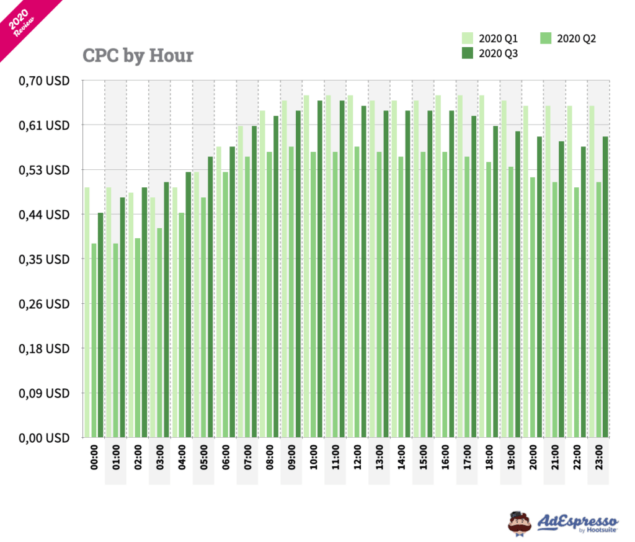
Facebook cost per click (CPC) by campaign objective - 2020
In 2020, the CPC for conversions was constantly decreasing during the first three quarters, from $0.70 in Q1 to $0.25 in Q3.
Though they didn’t have the data for the following quarters, AdEspresso projected that the CPC would start to increase again as businesses began to adapt to the new reality.
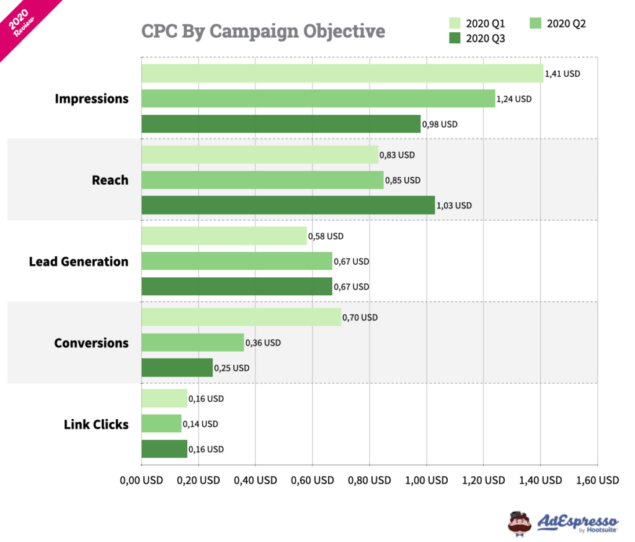
However, having in mind that, in 2019, CPC was about 50% higher for each quarter, the CPC today shouldn’t have reached the same heights as we’re still in the pandemic. If you’ve money to advertise your business, now it’s a good time to invest in Facebook ads!
How to distribute my Facebook ads budget?
According to Social Media Examiner, the world’s largest social media marketing resource, you should distribute your monthly ad spend for Facebook ads across three categories: audience building, offer promotion, and retargeting.

- Audience building – 20%
You should allocate about 20% of your Facebook ad budget to building your target audience. Of course, if you’re just starting with your ads, the percentage should be higher.
Ads in this category should educate your potential customers about your products or services and encourage them to engage with your brand. You’ll later use this audience to build your leads and, ultimately, sell your products with retargeting campaigns. - Offer promotion – 60%
Allocate about 60% of your total ad budget to promote your products and generate conversions. - Retargeting – 20%
Use the remaining 20% for retargeting people who visited your online store, thanks to your previous ad campaigns. As time goes by, you can increase your ad spend on retargeting, but make sure you have a constant stream of new people interested in your store. Otherwise, your retargeting audience will be too small to produce significant results.
How much to spend on Facebook ads?
If you don’t have a big marketing budget, you can spend as little as $1 per day on your Facebook ads. While this sum may seem too little to make an impact, you actually can get in front of many people.
As we saw before, according to AdEspresso, the average CPC (cost per click) in 2020 was $0.39. So, if you’d spend $1 daily for a month to advertise your online store on Facebook, you could get around 76 visits from highly motivated shoppers! 76 visits are better than no visits.
If you’re ready to invest more in your digital marketing, aim to spend enough money to help Facebook’s ad delivery system complete the learning phase faster.
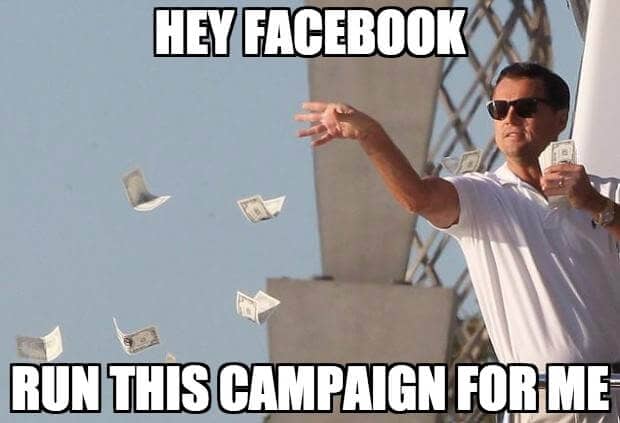
Facebook needs about 50 optimization events to complete the learning phase, so if you’re optimizing for CPC, your weekly budget should be around 50 x $0.39 = $19.5. Keep in mind that this calculation is based on an average Facebook cost per click, so your own results may vary – you may need to spend more.
Ultimately, you should always be aware of how effective your ads are and adjust your ad spend accordingly. To do this, you can calculate your Customer Acquisition Cost (CAC). Simply speaking, your CAC shows how much it costs you to get one customer.
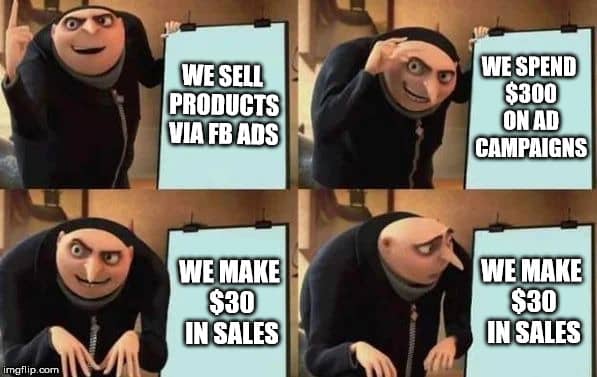
For example, if you spent $50 per month on Facebook ads and they got you 20 customers, your CAC is $50 divided by 20 = $2.5. If you see that you’re still profitable at this rate, you can increase your Facebook ad spend to get more sales.
How do you calculate the cost per ad on Facebook?
You don’t really need to calculate any metrics manually as Facebook Ads Manager does it for you. However, if you want to know how the calculations are made, here are the main metrics to help you understand how your Facebook advertising costs are calculated.
Cost per result
Cost per result shows how cost-efficiently you achieved your ad goals. Use it to compare performance among different ad campaigns and scale the best Facebook ads to get more sales.
To calculate our cost per result, divide the total amount spent during the selected period by the number of results.
The other two metrics you may be interested in are CPM (cost per 1,000 impressions) and CPC (cost per click). They are some of the most used bidding options.
CPM
CPM shows how much you spent to get 1,000 impressions. It’s best used for raising brand awareness.
To calculate your CPM, divide the amount spent on your ad campaign by its impressions and multiply the result by 1,000.
For example, if you spent $60 and got 10,000 impressions, your CPM is $6.
Check our article on 9 Ways Shopify Store Owners Can reduce Facebook CPM to be more profitable.
CPC
CPC shows how much one click costs you. It’s best used when you want people to click on your ads and visit your store.
To calculate your CPC, divide the total amount spent on your ad by link clicks.
5 ways how to reduce your Facebook ad costs
Now, let’s get to the good stuff that anyone who needs to run Facebook ads cares about. In the section below, you’ll find five tips on how to reduce the cost of Facebook ads.
1. Choose the right campaign objective
When you’re creating a new ad campaign, the first thing you need to do is to choose your marketing objective. This step is crucial, so don’t just click on whatever feels ok.
An experiment by biteable has shown that a wrong campaign objective can increase your Facebook advertising costs up to 4,238% more!
To use your ad dollars wisely, think carefully about what you want to achieve. Do you want your target audience to get to know your brand, or do you want to target those people who are ready to buy? Each goal is valid, you only need to fit it in your marketing funnel.
There are three main stages in a classic digital marketing funnel: Awareness, Consideration, and Conversion. Facebook offers different campaign objectives for each of these stages.
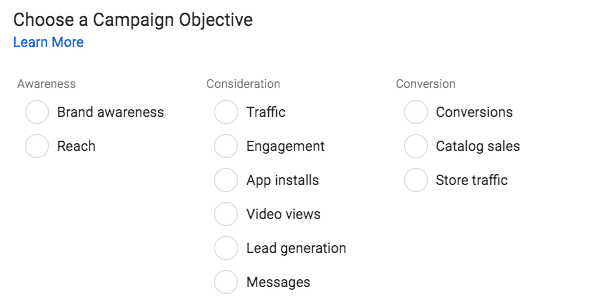
- Awareness – When your target audience doesn’t know about you yet.
Your task is to get their initial interest in your brand. You want your ads to be seen by as many people as possible. That’s why you should aim for Brand awareness or Reach objectives.
If you’d choose App installs and target people who aren’t familiar with your brand yet, you’d not get good results, as it’s simply too soon for these people to install your app. Only a few of them would convert and you’d waste your ad money.
- Consideration – When your target audience knows you exist and is evaluating your pricing and product features against your competitors.
At this stage, you should choose such objectives as Traffic to lead your potential customers to your product pages or Messages to get in contact with them and provide information. Learn about the top marketing strategies to sell via Facebook Messenger here.
- Conversion – When your target audience is thinking about buying from you.
This is the last stage of the funnel where you have the least people, but they’re highly interested in your brand. To get the most of your ad budget, choose Conversions as your campaign objective.
2. Narrow down your audience
Broad audiences will generate better reach metrics, but your conversion rates will be lower, too. It doesn’t make sense to try to get in front of people who are not interested in you, especially when Facebook offers robust targeting possibilities.
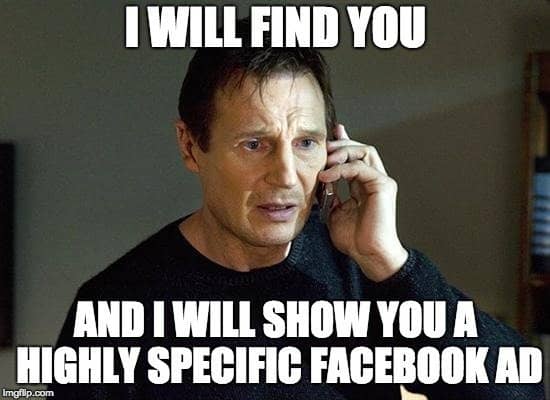
Specific audiences usually bring better results than broad ones because your ads are more relevant to a well-targeted audience. As a result, you waste less money on ineffective ads.
- If your store is still new, use Core Audiences to define your ideal customers.
- If you’re already getting traffic and sales, use Custom Audiences for retargeting people who abandoned their carts or encourage a repeat purchase.
- Finally, make use of Lookalike Audiences to find people similar to your best customers.
3. Monitor your ad relevance
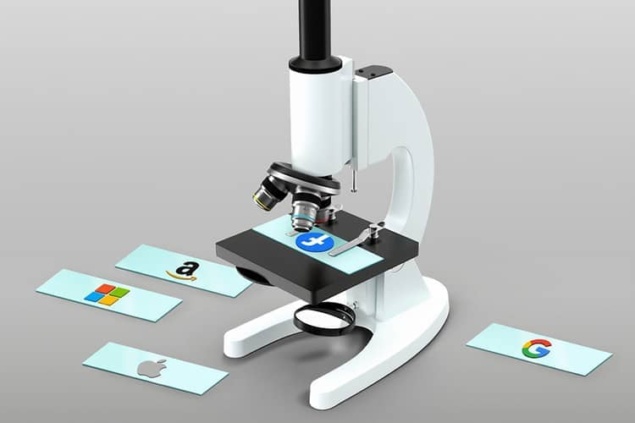
Facebook clearly states that “Ads that are more relevant cost less and see more results.”
How to know if your ads are relevant? Check Ad Relevance Diagnostics.
Ad Relevance Diagnostics evaluates your ads’ quality, engagement rate, and conversion ranking to determine if they’re relevant to your target audience.
You can find Ad Relevance Diagnostics in your Ads Manager, in the Performance column preset, or add them manually if you’re using custom column presets.
4. Lower your ad frequency
Your ad frequency is the estimated number of times each person saw your ad.
It’s recommended to keep your ad frequency below 3. If the number is higher, you’re risking overloading your potential customers and running into ad fatigue issues.

In other words, people will become bored of your ads and will stop responding to them. Your ad cost will increase, and your results will be worse, too.
You can check your ad frequency under the “Frequency” column in ads reporting.
To lower your ad frequency, rotate your ad creatives. You can either keep changing your ad visual or messaging. Even adding a text overlay or talking about different value propositions can make a big difference. Need some ideas? Check our list of 30+ Facebook ad examples to get inspired.
5. Automate Your Facebook ad management
Lastly, if you feel like Facebook advertising is a little too much to handle, especially if you have to manage other parts of your business, think about Facebook ad automation.
With apps like sixads, you can run your Facebook ads on autopilot.
Just think about it. You can set up your ads in just a few minutes, and you don’t need any knowledge about Facebook advertising. You simply need to approve personalized ad visuals, audience targeting, and text.
That’s it! You can keep on taking care of the rest of your business while our advanced algorithms run high-performing ads for you, minimizing your Facebook ad costs.
Facebook ads price vs. Instagram ads price
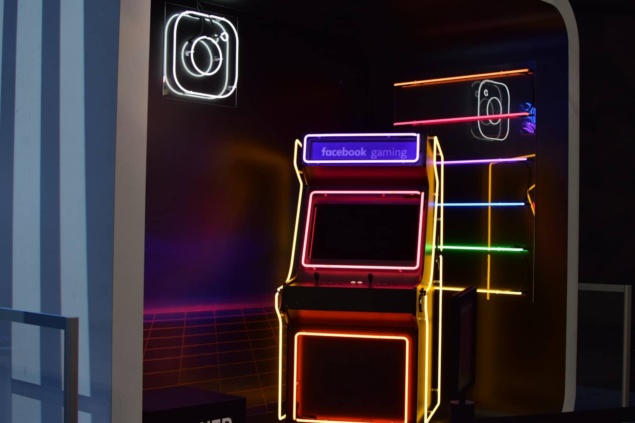
Multiple studies suggest that Facebook ads are cheaper than Instagram ads.
For example, Agorapulse carried out an experiment where they ran two split tests on Facebook and Instagram. The ads were identical except for their placement. They found that the average cost per click (CPC) for Facebook ads was 42.86% lower than Instagram ads. However, this doesn’t mean that you should only focus on Facebook ads since they tend to be cheaper.
While often more expensive, Instagram ads tend to have a higher engagement rate than Facebook ads, thanks to the very visual nature of the platform. This is especially true for the apparel industry, as this example from the team at DUNK Basketball has shown. Their Instagram ad campaigns generate 12x leads and sales compared to the ads on Facebook.
Still, you should take these numbers with a pinch of salt and always think for yourself. In the end, it’s not about choosing between Facebook and Instagram, but learning how to use both platforms in the most effective way for your business.
With sixads, you can run Facebook, Instagram, and Google ads on autopilot. Our winning strategies will find the best targeting for each advertising channel. With time, you’ll see which platform brings you the best results and will be able to increase your ad spend with confidence.
FAQ
How much does Facebook advertising cost in 2022?
Your Facebook advertising costs will depend a lot on your industry, campaign objective, and many other factors. However, typically your Facebook ads can cost you between $0.50 and $2.00 per click. According to Wordstream, the average cost per click (CPC) in Facebook ads across all industries is $1.72.
How much does a Facebook ad cost per day?
If you’re a small business owner and can’t allocate a big budget to Facebook ads but still want to start running ads, you can spend as little as $1 per day and make an impact on your business. As you get more and more customers, gradually increase your daily ad spend to scale your sales.
What’s the minimum budget for Facebook ads?
As long as you allocate enough budget for your optimization event, you can run your Facebook ads with a very small budget. For example, if you want Facebook to charge you for impressions (CPM), you can run your ads with as little as $1 per day for daily budgets. If you’re using the cost cap bid strategy, then your daily budget should be at least five times the amount of your cost cap. So, if you set a cost cap of $3, your daily budget should be at least $15.
What is Facebook advertising cost cap?
Cost cap tells Facebook how you want to bid in the ad auction. If you set a cost cap, you give Facebook an average amount of money you want to stay under while bidding. For example, if you’re optimizing for purchases, you may choose to set your cost cap as the maximum cost per sale that will still bring you profit.



